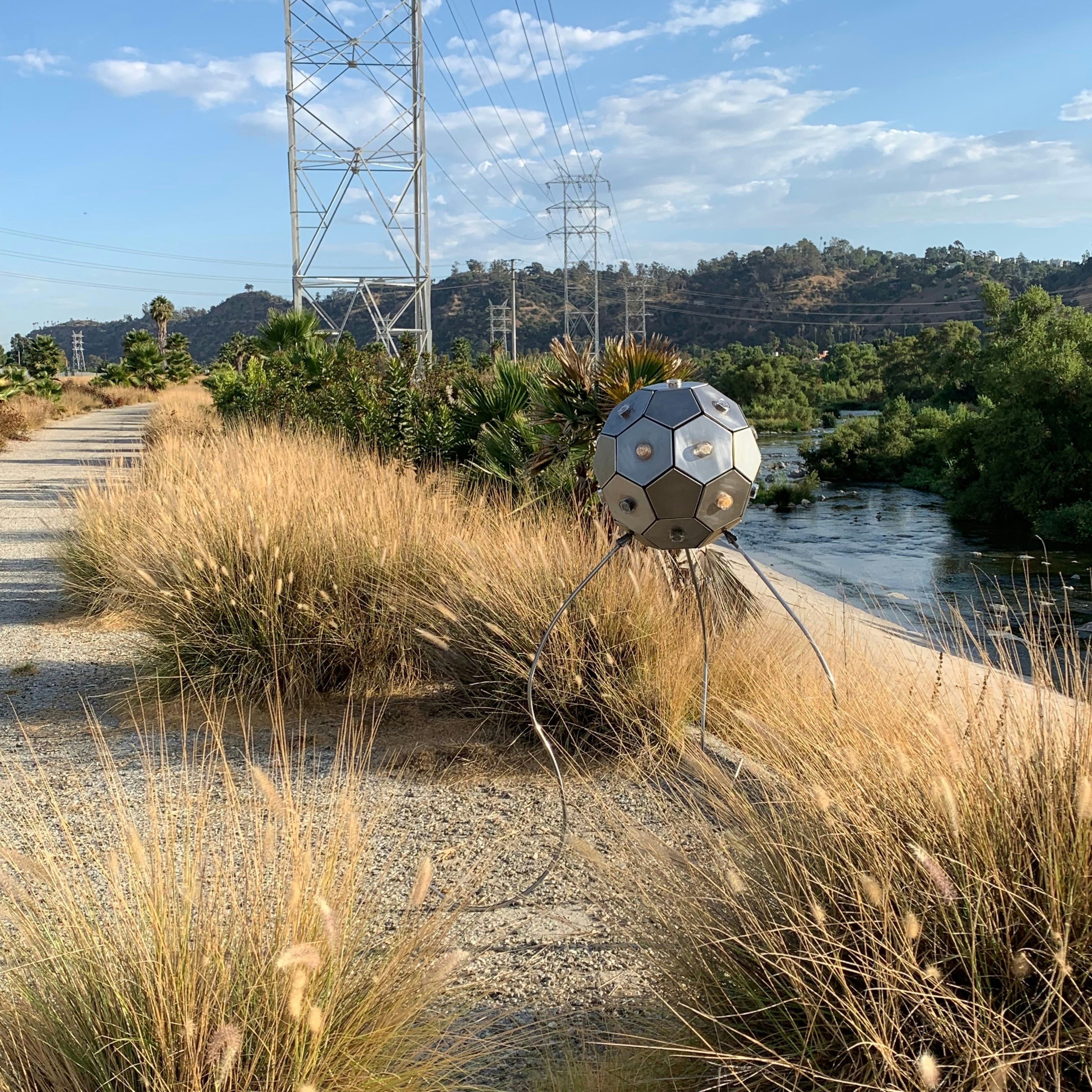
A Curatorial Perspective on Two Objects
The multidisciplinary works of Beatriz Cortez explore time and the untimely, simultaneity, and speculative imaginaries of the future. In Generosity I (2019), a steel sphere is suspended overhead. Its pentagonal and hexagonal panels are assembled into a mathematical form called a truncated icosahedron, commonly known as the pattern of a soccer ball. In the center of each hexagon, a transparent, node-like receptacle contains seeds of Indigenous non-GMO corn, beans, amaranth, quinoa, sorghum, and gourd—plants central to Mesoamerican quotidian and spiritual life. Three long appendages protrude from this hovering object, their spindly presence evoking antennae or the tropism of plant tendrils moving imperceptibly toward stimuli.
The form of Generosity I is reminiscent of the Russian satellite Sputnik, the first space probe launched into Earth’s orbit, in 1957. The Russian word sputnik translates as co-traveler, and Cortez’s otherworldly voyager likewise evokes the presence of another. Science has affirmed that plants retain a form of memory of past experiences, such as environmental threats, and they can apply their adaptive responses in subsequent situations and transmit that awareness epigenetically. With its bank of seeds, Generosity I serves as an offering, a gift of resources inscribed with knowledge and memories for potential future life forms. Its implicit call for communication with others in the present and in another time to come invites us to consider other dimensions and realms beyond the human. Within the probabilities of an outer space where Generosity I is present, the inheritance of things, feelings, and knowledge spans generations. In an act of generosity and hospitality, Cortez extends life into the future by offering seeds to imagined others whom she will never meet in a shared, intergenerational, and interspecies space.
Aroussiak Gabrielian’s art practice proposes novel modes of living that reshape our connections with the natural world and offer innovative solutions to some of the most intractable problems of our time. With her recent work Future Kin (2024), she introduces an affective and embodied composting ritual that speaks to multi-species symbiosis, collaboration, and heightened environmental consciousness.
Future Kin is the third project in a series that includes Posthuman Habitats (2018) and Liquid Breath (2023). All three engage the value of mutual depen- dence and the exchange of knowledge between species. Posthuman Habitats consists of vests made of layers of moisture-retaining fabric and containing seeds that sprout and flourish. These wearable gardens operate in a self- sustaining cycle, wherein human waste—sweat and urine—is directed into the organic material, fostering its growth. Gabrielian’s approach taps into ideas of transcorporeality, where the human body becomes an integral component of the ecosystem it supports. Her reimagining of clothing as a living landscape dissolves boundaries between nature and culture and human and environment. The work embraces the possibility of a world where human needs no longer take precedent over those of the flora and fauna that cohabit this planet.
Gabrielian extends the scope of cross-species engagement in Future Kin, which focuses on the biological process of organic decay through the act of com- posting. This installation, which includes video monitors, soil, ceramic objects, sound, and speakers, draws comparisons between the life cycles of humans, the biome in our digestive tract, and the bacterial, fungal, and animal medley that allows for the resurgence of new life in degraded soil. The multichannel video in the installation depicts a grieving ritual in which undulating hands move through soil in a choreography that caresses, laments, and cares for the decomposing organic matter. Future Kin implicates humans in the functioning of natural sys- tems and makes a case for the necessity of our direct engagement, empathy, and renewed awareness of our ecological interconnectedness.
Armory Center for the Arts
145 North Raymond Avenue, Pasadena
Gallery Hours
VIER.:2pm-6pm
SÁB.-DOM.:1pm-5pm
LUN.-JIEV.:CLOSED


Discussion Questions
- “Embrace diversity or be destroyed,” wrote Octavia E. Butler in her 1993 novel Parable of the Sower. For decades, activists, artists, scientists, and writers have imagined the consequences of severe disruptions to social, economic, and environmental systems and the impacts on our future. With climate change, the emergence of COVID-19, and international supply chains broken by shutdowns and warfare, once near-future threats are a dire reality. The “when, not if” question of such events occurring on a global scale is now past and makes the questions that have inspired this project even more urgent. What happens when mass populations that depend upon transnational capital for basic needs are systemically disconnected from production? What happens when the lights go out and power grids fail? Where is the knowledge for generating food and shelter?
- Such questions are frightening and can be overwhelming. Without recoiling from the challenges, From the Ground Up promotes unvarnished discourse among artists, scientists, and citizens to effect positive change. The project addresses questions of agency: What sustainable practices expand and promote our vision of community and sufficiency? How do past practices and today’s technologies inform this forward-looking project, and what unifying internal and external elements will allow civilization to serve its adaptive functions? How can low-impact, low-capital propositions and sustainable practices around seeds be visualized? How can artists, scientists, and activists envision a new and equitable world?
- Two organizing principles help humans understand our place in this universe: art and science. These two principles (or tools, approaches, modalities, or belief systems) derive from collective knowledge and evolve continuously. Aspects of this collective knowledge reside in body memory. The language of science is numbers – exact, precise, and measurable. Art, on the other hand, juxtaposes and re-configures perceptions of reality as its language.
- Within these mysteries, what can seeds tell us about the future? Seeds have provided food, clothing, shelter, and medicine for millennia, and for just as long humans have used sciences, technologies, myths, art, and poetry for predictive purposes.
Bibliographic References
